Episodes
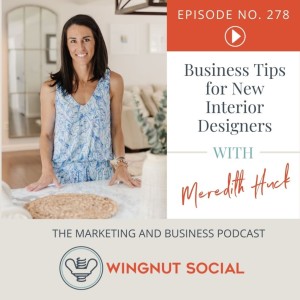
Wednesday Aug 17, 2022
Wednesday Aug 17, 2022
Meredith founded the “House of Huck” in 2020 as a passion project. She gave herself an ultimatum: If she wasn’t successful in three years, she’d go back to the corporate world. But in one year, she transformed her business into a full-time career.
She’s leveraged her unique background in corporate sales—and some genius social media marketing tactics—to build a thriving business. In this episode of Wingnut Social, Meredith shares some business tips for new interior designers that you just can’t miss!
What You’ll Hear On This Episode of Wingnut Social
[1:16] Wingnut Webinar: Let’s Get Real About Reels
[2:56] Mini News Sesh: Native scheduling on Instagram
[5:06] Learn all about Meredith Huck and the House of Huck
[11:08] Marketing House of Huck on social media
[18:03] When Meredith sought out an interior design coach
[20:43] How Meredith handles pricing and fees
[23:22] Why Meredith doesn’t want to grow and scale a team
[28:13] Business tips for new interior designers
[35:55] The What Up Wingnut! Round
[41:10] Blooper Reel!
Connect with Meredith Huck
House of Huck
Connect on Instagram
Resources & People Mentioned
Wingnut Webinar Aug 25, 2022 11:00 AM: Let’s Get Real About Reels
Profit First by Mike Michalowicz
Dakota Design Co.
The Brownstone Boys
Record your podcast episodes on Riverside
Why House of Huck grew quickly
95% of Meredith’s clients have come from social media. How does she leverage various platforms to gain visibility?
Meredith got in front of the camera. It allowed people to learn about herself and her life. She also embraced a unique social media marketing strategy: Throwing a scavenger hunt.
Meredith chose 5 local businesses, bought gift cards, and hid them around town. You had to follow her on social media and answer a riddle to find the gift card(s). Once someone found one, they had to tag her in a post.
She gained followers, gave back to her community, and it even led to a request for a design consultation.
Why Meredith doesn’t want to grow and scale a team
Meredith is struggling with a great problem to have: Getting too many requests for her design services. She’s learning how to take discovery calls, explaining how her process works, and scheduling out (sometimes weeks or months).
She sets the expectation that it may be weeks before she can connect back to work on their project. But then she communicates via email, notes in the mail, etc. She’ll have those clients work on creating a Pinterest board to fill in the gap during those weeks.
Meredith is busier than ever, but she isn’t interested in growing and scaling a team right now. She loves what she does and chooses to outsource when necessary. She works with a virtual assistant and outsources renderings and sourcing tasks.
Business tips for new interior designers
What has Meredith learned from her first couple of years as a new interior designer?
Tip #1: It’s not just about charging a design fee. Whenever you can, open up wholesale accounts and purchase furnishings directly from them. A large portion of Meredith’s revenue has come from the margin she makes on furnishings.
Tip #2: Trust your gut. Meredith agreed to do some design work for a couple despite seeing numerous red flags. Meredith requires her clients to request revisions within one week of her design presentation. After her design presentation, this client asked for more than a week to decide. Two months later, they asked her for a refund of her design fees.
Tip #3: Don’t take every job that comes your way. Only work with people who appreciate what you’re doing for them.
Meredith shares more tips, tricks, and business strategies in this episode of Wingnut Social. Check it out!
Connect With Darla & Wingnut Social
www.WingnutSocial.com
On Facebook
On Twitter: @WingnutSocial
On Instagram: @WingnutSocial
Subscribe on YouTube
Darla’s Interior Design Website
Check out the Wingnut Social Media Lab Facebook Group!
786-206-4331 (connect with us for your social media marketing needs)
Subscribe to The Wingnut Social Podcast on iTunes, Google Podcasts, or TuneIn
Audio Production and Show notes byPODCAST FAST TRACKhttps://www.podcastfasttrack.com
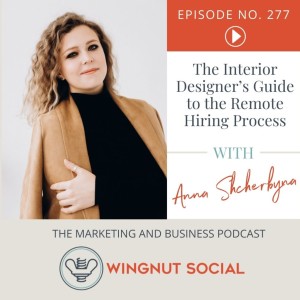
Wednesday Aug 10, 2022
Wednesday Aug 10, 2022
How do you navigate the remote hiring process for your interior design business? What should you include in the interview process? How do you retain a remote team once you hire them? Anna Shcherbyna joins Darla in this episode of Wingnut Social to tackle these questions head-on.
Anna Shcherbyna has over 10 years of experience in international operations and recruitment. She is the CEO of Remotivate, a recruitment agency that helps remote-friendly companies hire top remote management and leadership via a done-for-you service. Don’t miss her expert insight!
What You’ll Hear On This Episode of Wingnut Social
[1:24] Housekeeping: Wingnut Webinar Announcement
[2:25] Subscribe to Designed by Wingnut Social on YouTube!
[2:52] Mini News Sesh: How to Boost Instagram Reels
[6:55] Learn all about Anna Shcherbyna
[8:30] How the pandemic accelerated remote hiring
[12:03] The best places to hire remote employees
[14:00] What to look for in a remote candidate
[16:41] How to screen candidates remotely
[22:27] The advantages of hiring internationally
[26:49] How remote hiring can apply to designers
[28:43] How to nail the remote hiring process
[32:32] Ways you can retain your remote employees
[34:48] The What Up Wingnut! Round
Connect with Anna Shcherbyna
Remotivate
Book a demo call with Anna!
Connect by email at Anna@LetsRemotivated.com
Connect with Anna on LinkedIn
Resources & People Mentioned
August 24th at 11 am: Wingnut Webinar on Instagram Reels
VideoAsk
Remote
CliftonStrengths (formerly StrengthsFinder)
The Untethered Soul by Michael A. Singer
Record your podcast episodes on Riverside
Why hire a remote workforce?
As of early 2022, 50% of applicants on LinkedIn have been for remote jobs, but only 20% of the jobs posted are actually remote. The #1 reason why candidates are applying for new jobs is because they’re being forced back into the office. Why are employers still resistant to remote work?
Anna points out that when people work remotely, productivity goes up, flexibility goes up, happiness goes up, and morale goes up. But the one thing that you do lose out on is that quickness of communication.
How to screen candidates remotely
Anna recommends that you screen for soft skills. It isn’t just about experience anymore. You can’t just look at someone’s resume and LinkedIn profile and determine if someone is a good fit. You need to look for a hunger to learn, time and effort, independence and drive, and someone who is self-motivated.
Obviously, you still want to screen candidates to make sure they’re a good fit for the position you’re hiring for. To do this, Anna loves using VideoAsk. You can see if a candidate is comfortable on camera and better assess their passion and interest in the role.
Anna also recommends using some personality tests (DiSC and Clifton Strengths, which was formerly StrengthsFinder). CliftonStrengths asks direct questions, such as what you enjoy—and what you don’t—and how you act in different scenarios. It’s harder for you to answer questions from the lens of what you think the potential employer wants.
Lastly, she always recommends a test project that is actionable and strategically related to the position being hired for. Give them an actual scenario you’re facing within your business and ask them how they’d resolve it. What steps would they take? Have them create a strategic plan.
What are the advantages of hiring a remote employee internationally? Anna shares a few factors you might not have considered!
How to nail the remote hiring process
Step #1: Start with a questionnaire that tackles what a candidate has experience in, the tools they’ve used, industries they’ve worked in, and more. It’s about covering the logistics. Doing this can eliminate 70% of the people applying.
Step #2: Ask the remaining 30% to record a short video where they present themselves and answer a couple of questions that you’ve provided.
Step #3: Set up a conversation with the potential team member, interact with them, and conduct an interview.
Step #4: Give them a test project to complete. This will allow you to more fully understand what their skills are, how they communicate, and what their experience is. Plus, you get to see them live in action.
Step #5: Finally, complete reference checks. Ask them to prepare some previous clients or employers that they’ve worked with for at least 6 months, within five years, and no longer than five years ago. It needs to be with a supervisor who can speak to their character and growth.
If you set up the remote hiring process correctly, it creates a seamless experience for you and the new hire.
How do you retain remote employees? How can you set them up for success? Listen to the whole episode to hear Anna’s thoughts!
Connect With Darla & Wingnut Social
www.WingnutSocial.com
On Facebook
On Twitter: @WingnutSocial
On Instagram: @WingnutSocial
Subscribe on YouTube
Darla’s Interior Design Website
Check out the Wingnut Social Media Lab Facebook Group!
786-206-4331 (connect with us for your social media marketing needs)
Subscribe to The Wingnut Social Podcast on iTunes, Google Podcasts, or TuneIn
Audio Production and Show notes byPODCAST FAST TRACKhttps://www.podcastfasttrack.com

Wednesday Aug 03, 2022
Wednesday Aug 03, 2022
Maria Killam is a decorator, stylist, speaker, educator, and true color expert in interior and exterior design. She’s also the creator of the Killam Color System™, a proven system for choosing color that anyone can learn.
Maria has always shared her work on her blog and has thousands of readers. But her Instagram never took off—until recently. Maria leveraged a popular Instagram trend and grew to 100k+ Instagram followers in mere weeks. Learn how she did it in this episode of Wingnut Social!
What You’ll Hear On This Episode of Wingnut Social
[1:48] Housekeeping: Wingnut Webinar + YouTube
[2:50] Mini News Sesh: Instagram Feed Videos = Reels
[6:43] Learn more about Maria Killam and her business
[12:44] The basics of the Killam color system
[18:00] The importance of understanding color
[24:44] How Maria’s eDesign business stands out
[29:13] How Maria feels about white interiors (and trending colors)
[31:51] Maria’s marketing strategy on Instagram
[38:36] What Maria would say to someone who wants a trendy space
[40:30] Maria’s What Up Wingnut Round!
[46:29] Blooper Reel!
Connect with Maria Killam
Maria’s Website
Maria’s course: Colour Made Easy™
Follow Maria on Instagram
Resources & People Mentioned
At Your Best by Carey Nieuwhof
Record your podcast episodes on Riverside
The evolution of Maria’s business
Maria Killam launched her career while working in a paint store. She took a color course and learned how to accurately describe colors. As she helped clients choose the right colors for their homes, she started painting out large color samples and used them over and over again.
She saw that beiges always had the same undertones: pink-beige, green-beige, yellow-beige, etc. The undertones expanded from there. Her goal is to help her clients understand undertones so their design choices are complementary and timeless.
Maria created a color wheel tool to help people identify the undertones in their spaces to choose the right neutrals. Now Maria offers online courses and eDesign to help both designers and homeowners create timeless spaces.
Keep listening to learn how understanding color and undertones influences every design choice you’ll make.
Maria’s Strategy to gain 100k+ Instagram followers
Maria has spent a lot of time on Instagram. Why? Because people judge you as a marketer, designer, and businessperson based on your number of Instagram followers. They’re either impressed—or not.
One day, Maria was watching an influencer who did a “10 ways to do something…” video series that they split into 10 parts. It was a light-bulb moment for Maria. So she launched her own 10-part series: “10 Finishes that Immediately Date Your New Build.” Her Instagram following grew by 100,000 followers in a matter of weeks.
Instagram is trying to be like TikTok. It’s ALL about video. It worked for Maria because her no-nonsense personality was fully expressed in these videos. Before, she followed different random trends. Secondly, you build trust faster when they watch a video. If you’re not on video, you’re going to be behind. So how do you get started?
Start sharing videos on your stories. They’re only 15 seconds and get you comfortable in front of the camera. Maria felt extremely awkward in her first videos. But you have to go through that awkward phase to become a rockstar on video. Maria has attracted a whole new audience. Learn how you can do the same in this episode of Wingnut Social!
Connect With Darla & Wingnut Social
www.WingnutSocial.com
On Facebook
On Twitter: @WingnutSocial
On Instagram: @WingnutSocial
Subscribe on YouTube
Darla’s Interior Design Website
Check out the Wingnut Social Media Lab Facebook Group!
786-206-4331 (connect with us for your social media marketing needs)
Subscribe to The Wingnut Social Podcast on iTunes, Google Podcasts, or TuneIn
Audio Production and Show notes byPODCAST FAST TRACKhttps://www.podcastfasttrack.com
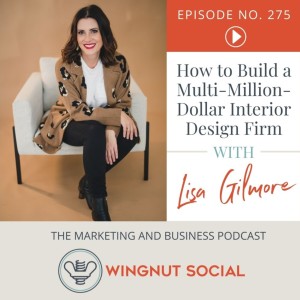
Wednesday Jul 27, 2022
Wednesday Jul 27, 2022
Lisa Gilmore watched HGTV late at night when her mother thought she was sleeping. As she watched Candace Olson from “Divine Design” put these incredible designs together, she realized she could do the same thing. She went to design school right out of high school.
When she started her business, she focused on networking. Her goal? When anyone heard the word “interior design” she wanted them to immediately think “Lisa Gilmore.” 11 years later, she’s been featured in Forbes, Business of Home, Coveteur, Better Homes & Gardens, and more.
Lisa is recognized for her bold use of color, functionality, and “liveable glamour.” She’s built a multi-million-dollar interior design firm from the ground up. But her journey wasn’t without setbacks. Listen to this episode of Wingnut Social to learn what she did to build a thriving multi-million-dollar interior design firm.
What You’ll Hear On This Episode of Wingnut Social
[1:20] Housekeeping: Check out this month’s webinar!
[2:05] Mini News Sesh: YouTube, Instagram, or TikTok for video?
[6:07] Learn all about the extraordinary Lisa Gilmore
[10:25] How Lisa became an interior designer
[15:34] Is it important to work with an established interior designer?
[17:27] Becoming a multi-million-dollar interior design firm in 10 years
[22:22] The changes Lisa made to her pricing structure to achieve growth
[26:00] What percentage of Lisa’s business is furnishings and accessories?
[28:34] What Lisa learned from hitting financial rock bottom
[33:45] How to prepare your interior design business for a recession
[38:00] Don’t be afraid to get uncomfortable to grow to the next level
[39:25] Lisa experiences the What Up Wingnut Round!
[42:52] The Wacky Wingnut Blooper Reel!
Connect with Lisa Gilmore
Lisa Gilmore Design
Follow Lisa on Instagram
Resources & People Mentioned
Scarlet Thread Consulting
Profit First by Mike Michalowicz
MasterClass episode with Sara Blakely
Divine Design
What Lisa learned from hitting financial rock bottom
Lisa grew up in a blue-collar family in a small town in Florida. She had what she needed, but she didn’t have a lot. Her family never talked about money. So when she started her business, she avoided conversations about money. But she notes that passion only gets you so far. She couldn’t ignore it anymore.
She was going through a divorce, trying to stand on her own two feet, but she couldn’t. She went to Africa on a sort of “Eat, Pray, Love” sabbatical. It was the experience of a lifetime. But a lack of confidence coupled with poor financial management culminated in the perfect storm. Lisa logged into her bank account and realized it was empty. That was the moment she realized she needed to get her life together.
Becoming a multi-million-dollar interior design firm in 10 years
A close friend introduced Lisa to Profit First, which quickly changed her mindset about money. It took Lisa 3–4 months to recover from rock bottom. Thankfully, she’s never had a shortage of clients, so she was able to put her nose to the grindstone and implement Profit First quickly. It was a painful process. But she dug them out of debt and started saving money.
Her experience forced her to look at her business as what it could be. It needed to be her livelihood. She had to get uncomfortable with money and learn to understand profit margins. And once she focused on a Profit First mentality, her confidence grew as a female leader and business owner.
She was no longer intimidated. She sat in front of her wealthy clients with confidence and knew she could provide what they needed and make a great living.
The changes Lisa made to her pricing structure to achieve growth
Lisa raised her hourly rate to $275 an hour and now requires a higher retainer up front so clients have skin in the game. They need to be invested. She can say without hesitation that it turned her business around. She emphasizes that if you allow yourself to face your fears, you can turn your financial mistakes around quickly.
Lisa shares more about her incredible interior design firm and her path to success and financial freedom in this episode. Don’t miss it!
Connect With Darla & Wingnut Social
www.WingnutSocial.com
On Facebook
On Twitter: @WingnutSocial
On Instagram: @WingnutSocial
Subscribe on YouTube
Darla’s Interior Design Website
Check out the Wingnut Social Media Lab Facebook Group!
786-206-4331 (connect with us for your social media marketing needs)
Subscribe to The Wingnut Social Podcast on iTunes, Google Podcasts, or TuneIn
Audio Production and Show notes byPODCAST FAST TRACKhttps://www.podcastfasttrack.com

Wednesday Jul 20, 2022
Wednesday Jul 20, 2022
Why is SEO so critical for your brand’s online presence?
How does it help you compete with other interior designers? Why is ongoing SEO the key to keeping your interior design business ranking on Google?
The biggest piece of misinformation that we hear about SEO is that it’s a “one-and-done” service that’s complete when your website is created. That couldn’t be further from the truth. Ongoing SEO, when done correctly, is your key to remaining competitive. Gavin—Wingnut’s resident SEO guru—covers this important topic in this episode of Wingnut Social!
What You’ll Hear On This Episode of Wingnut Social
[1:25] Wingnut Webinar 7/28 at 11 am EST: SEO 101
[2:50] Subscribe to Wingnut Social on YouTube!
[3:40] Mini News Sesh: Instagram Reel update
[7:42] Learn all about our SEO guru Gavin
[8:45] SEO isn’t “set it and forget it”
[13:30] Google’s algorithm and SEO
[17:42] The importance of recency and activity
[21:54] Tools and resources to leverage for SEO
[24:10] Ongoing SEO is the key to your business’s success
Resources & People Mentioned
Wingnut Webinar: 7/28 at 11 am EST: SEO 101
Wingnut Academy: Instagram for Interior Designers
Record your podcast episodes on Riverside
Wingnut Social is on YouTube!
How ongoing SEO can boost your business
When your website is created and SEO-optimized, you can’t just set it and forget it. You can’t just run ads and call it good. Why? 80% of people searching on Google ignore paid ads. Secondly, most people won’t go past the first page of search results. So your business needs to be ranked in the top 10 search results.
How do you achieve that? You have to track and measure the impact of your work and adjust your SEO continuously. You can make adjustments as you go to make sure your pages stay on the first page of Google’s search results.
Your competition’s SEO tactics are constantly changing. If you’re ranking for a keyword and it falls from #2 to #10, you need to make some adjustments or you’ll lose traffic. If your competition is ranking for keywords that you used to rank for, changes need to be made.
That’s why a robust and ongoing SEO strategy can mean the difference between being flooded with clients—or being irrelevant.
Your clients have questions—make sure you provide the answers
When it comes to blogging, people think they need to produce a chunk of new content once a month and they’re okay. Gavin points out that blogging is a great strategy and you need to do it. However, you have to keep in mind that Google is trying to connect people who have questions with the answers they’re looking for.
5–10 years ago, people would stuff keywords into a blog and rank for it. Google is now an intelligent platform that can’t be fooled. If you’re keyword stuffing, your content won’t rank. When you write content, focus on answering questions that your ideal client is searching for.
What questions are they asking? How do YOU provide the best answer and share value? The keywords and phrases you use reflect your ability to understand your customer. If you have a great idea of what your customers are looking for and provide them value, you’ll see a bump in SEO.
What tools can you use to help you write SEO-optimized content? How does Google’s algorithm play a role in your success? Listen to the whole episode to learn more about ongoing SEO’s impact on your bottom line.
Connect With Darla & Wingnut Social
www.WingnutSocial.com
On Facebook
On Twitter: @WingnutSocial
On Instagram: @WingnutSocial
Subscribe on YouTube
Check out the Wingnut Social Media Lab Facebook Group!
786-206-4331 (connect with us for your digital marketing needs)
Subscribe to The Wingnut Social Podcast on iTunes, Google Podcasts, or TuneIn
Audio Production and Show notes byPODCAST FAST TRACKhttps://www.podcastfasttrack.com
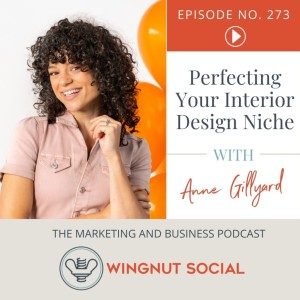
Wednesday Jul 13, 2022
Wednesday Jul 13, 2022
Anne Gillyard—along with Jodi Arellano—own and operate GrOH! Playrooms, specializing in educationally-based children’s interiors. They strive to create spaces full of color, joy, fun, and playfulness that encourage your child’s development. But how did they choose to niche down into something so specific? How have they built a thriving play-focused business? Anne joins Darla to discuss all things marketing, niching down, and incorporating play into your child’s every day.
What You’ll Hear On This Episode of Wingnut Social
[1:02] Subscribe to Wingnut Social on YouTube!
[2:01] Mini News Sesh: YouTube Shorts
[5:43] Learn all about Anne Gillyard
[7:55] How Anne chose her interior design niche
[12:39] How Anne reaches her ideal clients
[16:01] The benefit of industry partnerships
[22:36] How to choose work you enjoy
[25:05] Tips for mastering reels and videos
[28:55] The What Up Wingnut Round!
Connect with Anne GillYard
Connect on Instagram
GrOH! Playrooms
Resources & People Mentioned
Mike Michalowicz’s books
How Anne landed on a niche in playrooms
Anne worked in early education for years as a teacher and curriculum designer. But her expertise is play. She always wanted to be an interior designer but never thought she’d land there. Now, she designs family rooms, playrooms, bedrooms, and outdoor spaces where the intention is to live, breathe, and move around with your kids.
When they launched GrOh!, they were worried they wouldn’t survive if they niched down too far. So if a client asked them to do something outside their scope, they quickly agreed to it. But it wasn’t where they thrived. Once they fully committed to their niche, they took off. Now they have a waitlist of 6+ months.
How to choose your interior design niche
Anne says to pour your favorite drink, get comfy, and spend some time thinking. What lights your fire? What takes the least amount of energy to brainstorm about? When you complete a project, what are you proud of? How can you make your experience special? What can you do to make your relationship with your client wonderful and easy?
Reflect after every project and determine what you enjoyed—and what you didn’t. What did you find to be easiest? Anne once created a gorgeous custom kitchen, designed to help create independence for kids. While the project was a smashing success, they didn’t enjoy the work. Now, they only focus on what they love.
How GrOH! Reaches their ideal clients
In December 2019, GrOH! had committed to only doing commercial spaces. A few months later, because of covid, no one was going to commercial play spaces—maybe ever again. So they pivoted to residential spaces. Word-of-mouth wasn’t a possibility at that point. So what marketing stuck?
They invested in photography immediately. Then they hired social media out to professionals (Wingnut Social, of course) and the change was transformative. It’s allowed them to niche and establish themselves as go-to experts. Since then, 99% of their clients find them through social media.
And Anne is a social media genius. Her content is eye-catching, playful, and educational all while perfectly showcasing their designs. How has she found such social success (aside from Wingnut Social, of course)? She shares her tricks of the trade in this episode. Don’t miss it!
Connect With Darla & Wingnut Social
www.WingnutSocial.com
On Facebook
On Twitter: @WingnutSocial
On Instagram: @WingnutSocial
Subscribe on YouTube
Darla’s Interior Design Website
Check out the Wingnut Social Media Lab Facebook Group!
786-206-4331 (connect with us for your social media marketing needs)
Subscribe to The Wingnut Social Podcast on iTunes, Google Podcasts, or TuneIn
Audio Production and Show notes byPODCAST FAST TRACKhttps://www.podcastfasttrack.com
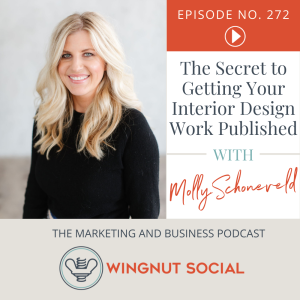
Wednesday Jul 06, 2022
Wednesday Jul 06, 2022
Molly Schoneveld is the award-winning PR strategist behind the luxury public relations firm, The Storied Group. She represents the industry's top interior designers, celebrities, and hotels, i.e. “Talented faces, spaces, and places.” She has 20+ years of experience with press placements in Architectural Digest, ELLE Decor, Vogue, and more. And she knows the secret to getting your interior design work published. What is it? Find out in this episode of the Wingnut Social podcast!
What You’ll Hear On This Episode of Wingnut Social
[1:13] Wingnut webinar and wingnut academy updates
[1:56] Mini News Sesh: LinkedIn’s repost update
[4:32] Learn all about Molly Schoneveld + The Storied Group
[7:08] Why proving publications enough images is important
[10:56] Do you need to hire a photographer with connections?
[16:06] Can a presence on YouTube help you?
[17:21] Do you need to have a celebrity client?
[20:15] Why you need to read photography contracts carefully
[23:16] Can you post the photos online if you want them featured?
[26:22] Make your photography stand out by using a stylist
[28:50] How to get your clients on board with being published
[33:46] How to stand out (and get hired by celebrities)
[38:20] The What Up Wingnut! Round
[40:26] How to connect with Molly Schoneveld
Connect with Molly Schone
The Storied Group
Connect with Molly on LinkedIn
Follow Molly on Instagram
Resources & People Mentioned
The Mystery Guest by Lorin Stein
Record your podcast episodes on Riverside
This is Marketing by Seth Godin
The secret to getting your interior design work published
What’s the secret? It all comes down to photos. Now—likely starting with Covid—many magazines will not do reshoots. What you provide them in your pitch is what will get published. So you need to give them enough photos to publish a full story. Luxe Magazine has design features that can be as long as 10–12 pages. That’s why you need to provide a variety of photos.
But Molly emphasizes that you don’t need the best photographer in the business. Why? You need to be able to afford someone who will provide you with a full range of images. What does that look like? If you want to get featured as a full home tour, you need 25–30 images of your work.
Molly landed one of her clients a feature in AD Digital. It was the home of a celebrity chef and a big-name interior designer. They didn’t reshoot the project. The photos Molly sent them were the photos that ran. The bar is high, and if you want to get into AD, you’ve got to be so much more than good. The photos you send must be shot knowing they’re going to be run in the magazine.
Do you need to hire a photographer with connections?
Molly points out that working with a specific photographer who has previously done work with the magazine you want to get published in can give you an advantage. But the advantage isn’t that the photographer can get you published—it’s that they know what the magazine is looking for. They understand the angles publications like, the styling they like, and the vignettes they prefer. Those are the things a photographer can help with.
But a magazine won’t say yes to a project solely based on the photographer. There are factors at play that are 100% out of your control, like editorial calendars, previously published homes and kitchens, and much more. But you can control your images. So work with a photographer who understands what magazines are looking for.
Make your photography stand out by using a stylist
Look at a potential photographer's social media. What is their aesthetic? That’s what you’ll end up with for your social media. What else is important? Molly believes that bringing in a stylist to bring life to your images makes the biggest difference. Magazines do this all the time. If magazine editors rely on them, designers should see them as someone who can bring their vision to life in a different way. That—coupled with a photographer versed in magazine photography—can make a huge impact.
Can you post photos online if you want them published in a magazine? Does it pay to have celebrity clients? Molly answers these questions and so much more in this episode. Don’t miss it!
Connect With Darla & Wingnut Social
www.WingnutSocial.com
On Facebook
On Twitter: @WingnutSocial
On Instagram: @WingnutSocial
Subscribe on YouTube
Darla’s Interior Design Website
Check out the Wingnut Social Media Lab Facebook Group!
786-206-4331 (connect with us for your social media marketing needs)
Subscribe to The Wingnut Social Podcast on iTunes, Google Podcasts, or TuneIn
Audio Production and Show notes byPODCAST FAST TRACKhttps://www.podcastfasttrack.com
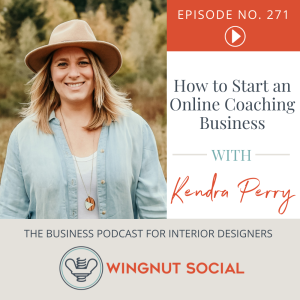
Wednesday Jun 29, 2022
Wednesday Jun 29, 2022
Have you thought about becoming an interior design coach? Maybe you’re burned out, ready to move on to another point in your career, or simply want some side income. Whatever the reason, online coaching might be the way to go. But how do you start an online coaching business? Do you dive in full-time, or dip your toes in part-time? Do you offer one-on-one coaching or group coaching?
In this episode of Wingnut Social, Kendra Perry—a former six-figure functional health coach turned online business strategist—shares how you can seamlessly build an online coaching business. Don’t miss it!
What You’ll Hear On This Episode of Wingnut Social
[1:30] Wingnut webinar and wingnut academy updates
[2:56] Mini News Sesh: How to calculate engagement rates
[9:17] Learn more about Kendra Perry
[11:47] The first steps: how to start an online coaching business
[15:34] How niched is too niched in the interior design industry?
[18:07] Online coaching: side hustle or a full-time job?
[19:40] Should you market your coaching business using current channels?
[22:00] Why you should start with one on one coaching
[26:14] The difference between Masterminds and group coaching
[30:00] The importance of communities to support group coaching courses
[31:55] How to structure an online course for your coaching business
[39:06] It’s time for the What Up Wingnut Round!
[41:00] How to connect with Kendra Perry
[42:50] Blooper Reel!
Connect with Kendra Perry
Kendra’s coaching website
Follow Kendra on Instagram
The Wealthy Coach Podcast
Resources & People Mentioned
Record your podcast episodes on Riverside
Engagement rate calculation: Engagement Numbers/Reach x 100
You Can Heal Your Life by Louise Hay
Circle Community Platform
Mighty Networks
The first steps: how to start an online coaching business
Everyone's an expert in something, right? Is there something you learned as an interior designer you wished you knew? Do you have expertise in a specific niche? It doesn’t have to be anything extraordinary. You don’t need specific education. You can take the knowledge you’ve acquired through your career and build it into an online program.
The most important thing you need to consider is your niche. What segment of the market are you going to target? What’s the single problem you solve for people? Who is that person? What are those people looking for? Kendra emphasizes that you aren't just selling coaching—you’re selling solutions to problems.
What outcome can you provide with your coaching? You can monetize any skills but you need to understand who you’re serving, the problem you’re solving, and the outcome you offer.
Should online coaching be a side hustle or full-time job? Should you market your coaching business using current channels? Listen to hear Kendra’s thoughts!
Why you should start with one-on-one online coaching
Many new coaches want to start with group coaching or an online course, but Kendra recommends beginning with one-on-one coaching. Why? Because it’s simpler. You don’t need a launch strategy, program hosting, modules, etc. You can reach out to your current audience and see who’s interested. You could have a coaching client the next day.
Secondly, if you don’t have a huge audience, one-on-one coaching will be easier to start with. The amount of feedback you’ll get is invaluable, which you can then take and apply to a group program. Anything you learn can be rolled into an online course.
To do something like group coaching or a course, you need volume to sell to and infrastructure in place. That’s why Kendra recommends giving yourself 6–12 months to bring in a full-time income. You have to build an audience and a list and those things take time.
When do you move to group coaching? And how do you structure an online course for your business when the time is right? Kendra is a wealth of information on this topic. Tune in to the whole episode to learn the ins and outs of building an online coaching business in the design space.
Connect With Darla & Wingnut Social
www.WingnutSocial.com
On Facebook
On Twitter: @WingnutSocial
On Instagram: @WingnutSocial
Subscribe on YouTube
Darla’s Interior Design Website
Check out the Wingnut Social Media Lab Facebook Group!
786-206-4331 (connect with us for your social media marketing needs)
Subscribe to The Wingnut Social Podcast on iTunes, Google Podcasts, or TuneIn
Audio Production and Show notes byPODCAST FAST TRACKhttps://www.podcastfasttrack.com
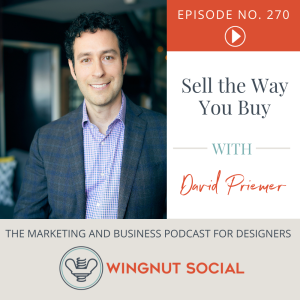
Wednesday Jun 22, 2022
Wednesday Jun 22, 2022
Do you cringe at the thought of selling your interior design services?
David Priemer, the author of Sell the Way You Buy, is the founder and Chief Sales Scientist at Cerebral Selling, where he teaches business owners the art and science of selling. His work hinges on the idea that you have to sell the way you buy.
Your clients aren’t just paying for the service that you offer. They’re buying emotions. They’re buying the experience. So how do you sell the way you buy? David shares great takeaways from his book in this episode of Wingnut Social!
What You’ll Hear On This Episode of Wingnut Social
[1:21] Wingnut Academy and webinar announcements!
[2:18] Mini News Sesh: Instagram launches pinning
[5:19] Learn all about David Priemer
[7:13] Why salespeople are viewed negatively
[9:05] People aren’t buying solutions—they’re buying emotions
[11:48] Bring awareness of problems to the surface with this tip
[16:??] How to handle experience asymmetry
[20:59] Remember that the experience is the product
[24:26] The importance of client retention
[30:33] The What Up Wingnut! Round
Connect with David Priemer
Cerebral Selling
Connect on LinkedIn
Watch on YouTube
The Cerebral Selling Lab
Resources & People Mentioned
Sell the Way You Buy by David Priemer
To Sell Is Human by Daniel H. Pink
Record your podcast episodes on Riverside
People aren’t buying solutions—they’re buying emotions
Covid prompted David and his wife to consider having their home redesigned. To him, the worst thing about a renovation is having to choose every detail. That’s why he’s willing to pay someone who will come in and remove all of the decision-making from his plate. He emphasizes that as an interior designer, you exist in the realm of emotional selling.
As you’re talking to your clients, think about the emotion behind why they’re buying. People don’t buy solutions to problems. People buy feelings—especially in creative spaces. So what is your superpower? How do you fill the void your buyer is looking for? It starts by knowing your audience and the feelings they’re buying when they buy you. It’s powerful.
Use this tip to sell the way you buy
If you wanted to sell someone a bandaid, you could look for someone who has a cut (i.e. a problem you can solve). But that requires they’re aware that they have a problem that needs to be solved. You could also look for clients that are afraid of getting cut, like someone who wants to update their house in preparation for selling it down the road. You’re selling the future.
The third way to sell is to “cut” people. What does David mean by that? Many people aren’t aware of the problem(s) that they have. When you look at a client's home, you might point out any issues or code violations that you see. You’re bringing problems to your customers. You help them realize there is a problem they need to be solved. You have to create a little bit of pain to address it.
How do you handle this when you struggle with being comfortable in the sales process? David shares a unique strategy any designer can use—keep listening.
Remember that the experience is the product
In chapter 4 of David's book, he talks about Disney World. Disney focuses on customer experience because the experience is the product. If David hires an interior designer, the experience he goes through to arrive at the final destination ends up influencing whether or not he’s happy with the end product. You have to create that experience.
You likely became an interior designer because you’re talented and passionate about your work. You love what you do. Why should you be ashamed of selling? You’re simply conveying the enthusiasm you have for what you do to your customer.
The experience the customer has with you transcends the final product. At the end of the day, people are buying feelings. People are buying emotions. You could be the best interior designer in the world, but if no one likes you, no one will hire you.
But if you create a great experience for your clients, they’ll tell other people about you. Selling with the way you buy in mind is a game-changer.
Connect With Darla & Wingnut Social
www.WingnutSocial.com
On Facebook
On Twitter: @WingnutSocial
On Instagram: @WingnutSocial
Subscribe on YouTube
Darla’s Interior Design Website
Check out the Wingnut Social Media Lab Facebook Group!
786-206-4331 (connect with us for your social media marketing needs)
Subscribe to The Wingnut Social Podcast on iTunes, Google Podcasts, or YouTube
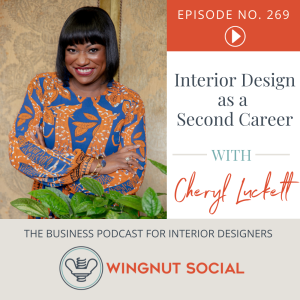
Wednesday Jun 15, 2022
Wednesday Jun 15, 2022
Have you considered interior design as a second career?
Cheryl Luckett had a 15-year career as a registered dietician and human resources professional. She launched Dwell by Cheryl after a weekly blog chronicling her home improvement projects quickly morphed into a side hustle decorating homes. After five years and a carefully planned exit strategy she dubbed “Project 36,” she left corporate life and made interior design her full-time career.
What You’ll Hear On This Episode of Wingnut Social
[1:43] Wingnut Webinar June 30th at 11 am
[2:40] Mini news sesh: Instagram’s repost option
[6:17] Project 36: Chery’s plan to transition to design
[16:36] The role of social media in building her brand
[20:02] Why you should invest in a business coach early on
[25:45] Why Cheryl chose to hire early in her business
[27:31] Hone in on a niche: Who are you here to serve?
[33:44] Approach each client with a service mindset
[34:48] What Up Wingnut! Round
[36:02] How to connect with Cheryl
[38:22] Blooper Reel!
Connect with Cheryl Luckett
Dwell by Cheryl
Cheryl’s collaboration with Wildwood
Follow Cheryl on Instagram
Resources & People Mentioned
The Dynamic Laws of Prosperity by Catherine Ponder
A Well-Designed Business® Podcast
Me by Design Coaching
Tobi Fairley Design
Record your podcast episodes on Riverside
The next Wingnut Webinar: June 30th at 11 am
Cheryl’s exit strategy: Project 36
After 10 years in the same company, Cheryl realized something wasn’t clicking. She didn’t want to be there forever. At the time, she had just purchased her first home and started decorating it. It sparked something inside her.
So she took some design courses at her community college, starting with basic drafting. She fell in love with design. She started a blog sharing her ongoing home projects, which led to clients within her circle of influence. A couple of years of night classes later, she realized she was on to something. But she needed a plan to transition out of corporate America. She called it “Project 36.” It was her 36-month exit strategy out of corporate.
She was single, had been in the same job for 12 years, and had great benefits—including stock options. The one thing that would keep her from making the move was financial. So she hired a financial planner and said, “I want to leave my job in 36 months. Help.” They set out a plan to chip away at student loans and save money so she felt comfortable with her career change.
She set a timeline for everything she needed to get done. The plan unfolded over time. The more the months ticked away, the more comfortable and confident she became about taking the leap. She needed to be strategic. She believes anyone considering a second career should be the same.
Transitioning to interior design as a second career
As Cheryl’s 36 months ticked onward, she posted three times a day on social media. It allowed her to engage in a community she wasn’t a part of full-time—yet. It allowed her to build demand for her service before she needed it. She brought people along on her journey. They knew she worked full time, knew she was in school, and knew she was building a side hustle.
Her followers were so bought into her story that when she shared a video of leaving the ivory tower, they were excited with her. Now, every December 31st, she posts that video. She executed her plan, made the leap, and is still thriving because of it. What else did she do?
Cheryl spent a lot of her PTO traveling to design conferences, investing in herself and her growth. She built relationships with people on an upward trajectory. Once she transitioned into her design business, she continued to invest in herself to continue on the path of growth.
So she hired a coach—Kim Kuhteubl. It was a significant investment but helped her understand that it’s an inside game. To show up for your business, sell your services, and serve people—you’ve got to have your mind right. It was the best move she made in the beginning stages. Her coach helped her with mindset, branding, visibility—all of the big picture things.
Listen to the whole episode to find out why honing in on a niche and having a process in place to find the right clients is a key part of her success.
Connect With Darla & Wingnut Social
www.WingnutSocial.com
On Facebook
On Twitter: @WingnutSocial
On Instagram: @WingnutSocial
Subscribe on YouTube
Darla’s Interior Design Website
Check out the Wingnut Social Media Lab Facebook Group!
786-206-4331 (connect with us for your social media marketing needs)
Subscribe to The Wingnut Social Podcast on iTunes, Google Podcasts, or TuneIn
Audio Production and Show notes byPODCAST FAST TRACKhttps://www.podcastfasttrack.com
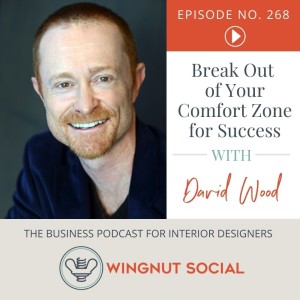
Wednesday Jun 08, 2022
Wednesday Jun 08, 2022
David Wood coaches high-performing business owners to double revenue—and their time off—by focusing less and being 30% more courageous in their business or career. Achieving more success sometimes means you have to break out of your comfort zone. David shares some tangible ways you can do that in this episode of Wingnut Social. Are you ready to “Get out there, get uncomfortable, and be great?”
What You’ll Hear On This Episode of Wingnut Social
[1:41] Wingnut Academy & Wingnut Webinar Announcements
[2:33] Mini News Sesh: Google’s Core Search Update
[5:38] Learn more about David Wood
[8:32] How David took a leap of faith and became an actor
[12:52] Reaching your goals takes focus and discipline
[20:56] How to be “30% more courageous”
[27:33] How do you balance being sensible AND daring?
[30:13] David’s journey towards personal growth through acting
[32:33] The What Up Wingnut Round!
[33:21] Learn more about the Mouse in the Room mission
[39:00] Blooper Reel!
Connect with David Wood
Go to MouseInTheRoom.com and get notifications for the nook launch. Set an alarm for 12pm Pacific on June 13th. Go buy as many books as you can and gift them to your friends. Amazon will let you send them the Kindle version. If you believe it deserves a review, come back one day later and leave a five-star review.
David’s Coaching Business
Connect with David on LinkedIn
Resources & People Mentioned
Loving What Is: Four Questions That Can Change Your Life
Record your podcast episodes on Riverside
Why you need to identify your “mouse in the room”
David is releasing a book called “Mouse in the Room” (because the elephant isn’t usually alone). It’s all about addressing the little animals in the room (i.e. fears) you may not normally share with someone.
When you reveal your fear and connect yourself to it, it can help you overcome it. Once you get clarity on what you’re afraid of, you can choose to tell the other person/people. It makes a decision or action far less scary.
David has always been drawn to performance—improv, standup comedy, motivational speaking, music, etc. But he was hesitant about acting. But 8 months ago, he realized he wanted to move to LA, get training, get an agent, and audition. He had never told anyone about the desire. But he “named the mouse” and shared the desire with someone.
Naming the mouse gave him energy. And the friend he’d shared with called him a week later and asked him to join her to audition for a professional production of a play. So he did. He got cast as the lead. Now he can say he’s a working professional actor. He’s still a coach and a trainer—and he’s also following his dreams.
David shares a powerful thought: "Just because you see someone do something that seems courageous doesn’t mean that they’re fearless. But they’re willing to have that fear and work through it.” How can you go for it and honor yourself so you don’t say, “I wish” on your deathbed? It takes courage to give your all and live your life.
Reaching your goals takes focus and discipline
Entrepreneurs see all of the possibilities. But they can only spread themselves so far. You add in social media, text messages, phone calls—it’s no wonder that most people are dealing with stress and anxiety. It slows down your goals.
Sometimes you need someone else to help you say “stop.” By focusing on less, you can produce more. It’s possible to get twice as much of the personal stuff done in half the time you’re spending now. How?
The answer is discipline. What matters to you over the next twelve months? What are the three business goals and the three life goals that matter to you that will have you celebrating 12 months from now? When you achieve one of these goals, return to your full list of goals and add a “Bonus goal” into the mix. This is only for people who want to be extraordinary.
How can you be “30% more courageous?” How do you balance being sensible AND daring? Listen to hear David’s thoughts!
Connect With Darla & Wingnut Social
www.WingnutSocial.com
On Facebook
On Twitter: @WingnutSocial
On Instagram: @WingnutSocial
Subscribe on YouTube
Darla’s Interior Design Website
Check out the Wingnut Social Media Lab Facebook Group!
786-206-4331 (connect with us for your social media marketing needs)
Subscribe to The Wingnut Social Podcast on iTunes, Google Podcasts, or TuneIn
Audio Production and Show notes byPODCAST FAST TRACKhttps://www.podcastfasttrack.com
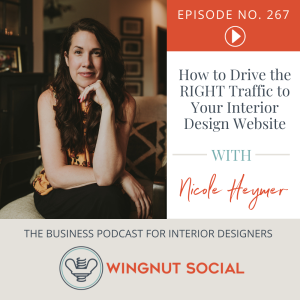
Wednesday Jun 01, 2022
Wednesday Jun 01, 2022
How do you drive the right kind of traffic to your interior design website? How do people who want the services you provide find you? How do strategies differ for local and national traffic? Everyone knows they need a plan to drive traffic, but it can be overwhelming—which is why it’s often put on the back burner. In this episode of Wingnut Social, Nicole Heymer of Glory & Brand will help you nail down where to start and how to drive the right traffic to your interior design website. Don’t miss it!
What You’ll Hear On This Episode of Wingnut Social
[1:31] Wingnut Academy & Wingnut Webinar Announcements
[3:15] Mini News Sesh: Instagram shakes up Stories
[7:06] Driving traffic to your interior design website
[15:05] Focus on your messaging to demonstrate your niche
[20:52] The importance of content marketing to drive traffic
[27:43] The impact of including video on your website
[33:47] Use social media marketing to serve a larger audience
[36:24] Why you have to focus your efforts carefully
[37:35] How to use email marketing to drive traffic
[40:04] Networking to drive traffic to your website
[45:03] The What Up Wingnut Round!
[47:30] How to connect with Nicole Heymer
[49:40] Blooper Reel!
Connect with Nicole Heymer
Glory & Brand
Glory & Brand on Instagram
Resources & People Mentioned
Record your podcast episodes on Riverside
Ubersuggest
Semrush
The E-Myth Revisited by Michael Gerber
Clockwork by Mike Michalowicz
Driving traffic to your interior design website: Where to start
Your website won’t drive traffic to itself. To figure out where to start, you need to ask yourself some questions:
What is your area of service? Is it local? Is it national? If it’s local, you have to tell the humans and search engines where you service (city, suburb, county?). Ask yourself what you would search for. If you’re trying to reach a national audience, your only hope is to niche.
Start by focusing on local search to establish a presence. It gives you credibility. If you want to build a national brand, focus on social media and building an email list. That's how you get in front of a large audience. An email list gives you control over your audience and the ability to directly market to them.
Secondly, where are you now? Where do you want to go? Who’s coming to the website and where are they coming from? Go to Google Analytics and look at “acquisition.” You can see where people are coming from (social, organic, etc.) You can use a tool like Ubersuggest, SEMrush, Ahrefs, etc. to gauge traffic, research keywords, and even spy on competitors. It’s fun to see how your keywords are growing and moving up in rankings. If you aren’t showing up in organic search, you can see it as an opportunity.
The importance of content marketing to drive traffic to your website
Content marketing is creating content that will educate, entertain, or demonstrate expertise. You can push it on social media but SEO and content marketing are intrinsically linked. You can optimize a homepage—and you should—but the real power in SEO comes from creating content.
If you want people to find you for a search term, you need one page dedicated to that search term. Search results are answers to a question. If you provide a robust answer to the question—that matches the search intent—you’ll start showing up in Google searches.
You can take two approaches with content:
Locally focused SEO and content
Ranking for high volume traffic-driving keywords
When Google sees that you’re getting traffic, it raises your domain authority, making you more likely to show up in local searches.
Location and service pages can be a major tool for local bases. Optimizing your google business page because it is low-hanging fruit for local search. Your actual location will help you show up in map searches. If you want to show up for other towns, you can create location pages that you optimize for interior design in such-and-such towns. You want to link to these pages on your website, but the goal is to rank in search. It’s a classic SEO technique that still works.
When it comes to local SEO, the reason Nicole prioritizes this over other methods of traffic is because of intent. Someone is searching for local interior designers, they’re serious. But local SEO can’t be everything. You need to leverage social media, email, and other strategies to have a well-rounded source of traffic. The messaging on your website will help you stand out.
Why should you use video strategically throughout your website to increase traffic? How can you use social media marketing to serve a larger audience? Listen to learn more!
Email marketing: The underused driver of website traffic
Email marketing allows you to drive traffic to your website at a specific time of day. It’s also highly cost-effective—whether you’re paying for a copywriter or doing it yourself. The con is that you have to work to build an email list. The people who are serious about email marketing build numerous opt-ins to get people on their list—quizzes, live speaking engagements, interactive lead magnets, etc.
A perceived con is that everyone hates getting emails. However, there are at least 1–2 emails that people always want to read. They’re educational, entertaining, informational, etc. You can be as accretive as you want.
Why do you need to focus your efforts carefully? How do you use email marketing to drive traffic? How can purposeful strategic networking drive traffic to your website and design firm? Listen to the whole episode for Nicole’s genius advice.
Connect With Darla & Wingnut Social
www.WingnutSocial.com
On Facebook
On Twitter: @WingnutSocial
On Instagram: @WingnutSocial
Subscribe on YouTube
Darla’s Interior Design Website
Check out the Wingnut Social Media Lab Facebook Group!
786-206-4331 (connect with us for your marketing needs)
Subscribe to The Wingnut Social Podcast on iTunes, Google Podcasts, or TuneIn
Audio Production and Show notes byPODCAST FAST TRACKhttps://www.podcastfasttrack.com
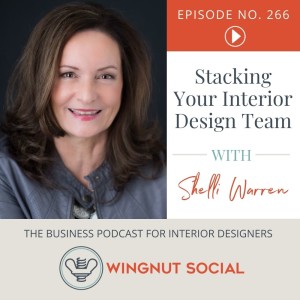
Wednesday May 25, 2022
Wednesday May 25, 2022
How do you build your interior design team when the current job market is a race for talent? Hiring stellar candidates isn’t easy in a competitive market. So how do you appeal to your ideal hire? How do you retain top talent? What’s the best method for promoting from within? These are just a few of the questions Shelli Warren answers in this episode of Wingnut Social!
Shelli Warren is a team and leadership coach and the host of the podcast, “Stacking Your Team.” She leverages 26 years of experience to deliver multi-million dollar projects for billion-dollar brands. She helps small business owners hire, fire, and inspire a team of high-performers.
What You’ll Hear On This Episode of Wingnut Social
[3:14] The next Wingnut Webinar: June 30th at 11 AM
[4:10] Mini News Sesh: How to show up on social media
[8:24] Learn all about Shelli Warren
[10:33] How to create a stellar job posting
[19:19] Involving your team in the hiring process
[22:06] The mission of a career portal on your website
[27:31] The importance of the interview (even for promoting from within)
[31:54] The qualities Shelli looks for in leadership
[36:50] How do you retain employees for the long haul?
[41:43] The importance of a benefit package
[45:53] Build out a career path for new hires
[48:05] The What Up Wingnut Round!
Connect with Shelli Warren
The Stacking Your Team podcast
The BizChix Podcast
BizChix Leadership Lab
Connect on LinkedIn
Resources & People Mentioned
Record your podcast episodes on Riverside
Get FREE shipping on your first order from Article
Check out the Wingnut Webinar on June 30th at 11 AM
Groh Playrooms on Instagram
The Signature of All Things
How to create a stellar job posting
When you’re hiring, you have to become a marketer. You have to position a job as the best career opportunity anyone would come across. You need to market the job opportunities, team culture, and clients. You position yourself as a place of work where someone can have a career—not a job. Why? People have had it with their jobs. They want something creative and worthwhile. You need to create visuals so potential hires can see themselves working alongside you.
If you’re selling a product or service, you have to tell its story, right? You want to position your role the same way. Share what a “day in the life” looks like. Paint a picture so they can see themselves in that role long-term. It helps decrease turnover. You want to be able to confidently select the people that will join your team that are in it for the long haul.
Shelli notes that you must be transparent about compensation and benefits. Many people who had really incredible salaries get to a point where it isn’t about the money anymore. They want to feel like what they’re doing is worthwhile. But you need to put the salary out there in black and white. Be professional and say: here’s the role, the title, what the role looks like, the anchor skills, and the compensation. If it aligns with their career goals, they’ll want to meet with you. If someone isn’t okay with that number, don’t waste each other’s time.
How can new designers create a compelling job description when they don’t have a solid team culture to brag about? Listen to hear Shelli’s thoughts.
How do you retain employees for the long haul?
Shelli jokes that you have to remind your team just how good they have it! She notes that you can read testimonials to your team. Share the goals that you are crushing. It’s about creating storylines where everyone understands their role and how it rolls up into the mission of the business.
Don’t be afraid in one-on-one conversations and quarterly reviews to give people shoutouts and remind them what they bring to the business. Make sure it isn’t just the “rock stars” who are getting the spotlight. Every rockstar has a team supporting them. Acknowledge everyone on the team and remind them that the work they do is worthwhile.
Great leaders know how to intrinsically motivate their team with real data. It’s more than “way to go” and “good job.” Your team wants professional feedback that assures them that you notice how hard they work day in and day out.
What role does a career page on your website play in hiring? How do you leverage LinkedIn, Indeed, and networking to stack your interior design team? Listen to the whole episode for some amazing insight from Shelli.
Connect With Darla & Wingnut Social
www.WingnutSocial.com
On Facebook
On Twitter: @WingnutSocial
On Instagram: @WingnutSocial
Subscribe on YouTube
Darla’s Interior Design Website
Check out the Wingnut Social Media Lab Facebook Group!
786-206-4331 (connect with us for your social media marketing needs)
Subscribe to The Wingnut Social Podcast on iTunes, Google Podcasts, or TuneIn
Audio Production and Show notes byPODCAST FAST TRACKhttps://www.podcastfasttrack.com
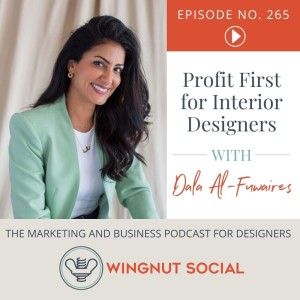
Wednesday May 18, 2022
Wednesday May 18, 2022
Mike Michalowicz’s “Profit First Method” flips traditional methodology on its head. Most people subtract expenses from earnings and whatever is left is “profit.” But you started a business to profit, right? So you should take your profit first and use whatever is left to operate your business. It shifts your mentality, leans your business, forces you to be creative, and leads to profit.
Dala Al-Fuwaires knows firsthand. She implemented the profit first method at her commercial interior design firm, House of Form. In this episode of WingnutSocial, Dala shares how interior designers can implement this practice in their business—and how embracing this methodology has impacted her business.
What You’ll Hear On This Episode of Wingnut Social
[3:20] Wingnut Webinars and Wingnut Academy Updates
[5:06] Mini News Sesh: Facebook launches new ‘Bubbles’ feature
[7:54] Learn about Dala Al-Fuwaires and House of Form
[9:43] What is the profit first method?
[13:05] How banking works on the profit first method
[17:45] How implementing profit first has impacted Dala’s business
[23:28] Dala’s marketing strategy for House of Form
[26:21] Where interior designers should get started
[29:00] Could a profit-first mentality help you sell your business?
[32:03] The What Up Wingnut round!
[36:24] Blooper Reel!
Connect with Dala Al-Fuwaires
House of Form
Follow on Instagram
Connect on LinkedIn
Resources & People Mentioned
Wingnut Webinars: 6 Ways to Infuse Personality into a Luxury Brand
Get Wingnut Academy Updates
Follow us on Instagram and you just might win a scholarship to our Instagram for Designers courses!
Get FREE shipping on your first order from Article
Profit First by Mike Michalowicz
Built to Sell by John Warrilow
How to implement the profit first method
Because the profit first method involves allocating revenue very specifically, it’s best to have separate bank accounts for each “bucket.” When Dala implemented profit first, she modified it slightly to suit her interior design firm: Dala uses four main accounts:
Opex: This account is for anything that involves operating expenses for the business. This includes things like payroll, your lease, marketing, computer programs—anything that is an expense for the business.
Tax distribution: Dala immediately sets aside 15% for taxes so at the end of each quarter she can make a payment to the IRS and not worry about where it’s going to come from.
Owner’s Pay: As the business owner, you need to make sure you’re getting paid for your work!
Profit: This is where you allocate bonus funds that can be put toward advancing your business. For example, Dala used it to build out an office for her team.
Each account is broken into a different percentage based on the performance and revenue of the company (i.e. Dala sets aside 10% of every check that comes through for profit). Every “Financial Friday” Dala spends the first hour of the day distributing funds into its respective account.
How implementing Profit First has impacted Dala’s business
Before embracing the Profit First method, Dala had one account. She wasn’t on payroll and her salary was whatever was leftover at the end of the month. But when you implement profit first and go through the exercise of dividing up the money in various accounts, you realize what the revenue needs to be to meet the goals for your business. It allowed Dala to carefully evaluate big decisions.
Logistically, she points out that it’s easy to log in to your bank account and look at each designated account and know what funds are available in each bucket. Dala can make informed decisions fast, such as hiring a new team member. It gives you the structure needed to run a successful business.
Where should interior designers start?
Read the book. Talk to peers who have implemented the profit first method who can share some insight. If your business isn’t profitable, Dala believes that you can still implement this method. It will be the push you need to become profitable. It forces you to think differently about how you run your business.
How can the profit-first mindset help you sell your business in the future? What next steps should you take? Learn all about it in this episode of Wingnut Social!
Connect With Darla & Wingnut Social
www.WingnutSocial.com
On Facebook
On Twitter: @WingnutSocial
On Instagram: @WingnutSocial
Darla’s Interior Design Website
Check out the Wingnut Social Media Lab Facebook Group!
786-206-4331 (connect with us for your social media marketing needs)
Subscribe to The Wingnut Social Podcast on iTunes, Google Podcasts, or TuneIn
Audio Production and Show notes byPODCAST FAST TRACKhttps://www.podcastfasttrack.com

Wednesday May 11, 2022
Wednesday May 11, 2022
Do you avoid sending prospective clients to your interior design website? Is it outdated with little copy? Does your website bring in any leads? If your website isn’t working for you, you’ve got a problem that Katie O’Brien can help you fix. Katie O’Brien is a brand and website designer specializing in elevated branding and fuss-free websites for interior designers. In this episode of The Wingnut Social podcast, Katie shares the type of copy to use, the right way to direct a prospective client to your contact form, and how to know when it’s time to revamp your website. Check it out!
What You’ll Hear On This Episode of Wingnut Social
[2:47] Wingnut Academy and Wingnut Webinars!
[4:06] Mini News Sesh: Instagram prioritizing original content
[7:56] Learn all about website designer Katie O’Brien
[10:34] Why “If I build it, they will come..” is the wrong mentality
[14:32] How to get ideal clients from your website
[17:20] What type of copy to avoid—and what to embrace
[18:47] How to answer the budget question on your website
[25:35] The proper amount of copy to have on each page
[27:12] Why your portfolio page still needs copy to tell a story
[29:10] 5 signs that an interior designer has outgrown their website
[33:02] How to direct your client’s steps on your website
[35:32] Strategic testimonials can propel customers toward you
[36:40] How to make lead magnets valuable to your clients
[38:13] The What Up Wingnut Round!
[42:04] Blooper Reel!
Connect with Katie O’Brien
Katie’s Website
Connect on LinkedIn
Resources & People Mentioned
Building a StoryBrand by Donald Miller
Business Made Simple with Donald Miller
Why “If you build it, they will come..” is the wrong mentality
Is your website getting traffic? Are you getting traffic but it’s not converting? Or are you not getting traffic at all? Kate notes that many factors that can impact this. But the first question she usually asks is, “Are you doing anything to bring traffic to your website?”
Your website should be where your social media, media appearances, new inquiries, DMs—everything should be directed to. Once there, your website needs to strategically guide visitors to take a desired action.
If someone is looking to increase traffic, the answer is SEO. Katie’s biggest recommendation is to add regular, relevant, and consistent content to your website. You must make sure it’s SEO optimized and then share it everywhere. People don’t understand that ongoing SEO is necessary. It means blogging (and updating blogs), writing metadata, adding photos, building your portfolio, link-building—and so much more—consistently.
How to get ideal clients to connect with you
Katie says to look at your website copy. What are you saying? Is it strategically speaking to your ideal client? Who is your ideal client? Many people don’t have their ideal client nailed down and it’s a mistake. You need to get specific about your ideal client—who are they? What are their pain points? How are you helping them with that? Does your website content speak to that person? You need to direct them to the next step.
The next step is usually to complete a contact form or book a discovery call. All of your calls to action should work toward that goal. Teach them who you are, qualify them, and give them information about you to direct their steps. Think about the end result first. How does every page work toward that? Keep listening to hear how Katie suggests structuring pages to drive visitors to your call to action.
5 signs it’s time to revamp your interior design website
Kate shares 5 signs when you KNOW it’s time to hire a pro:
Your business is running almost entirely on referrals: While referral business is positive, it’s also a red flag. It means your website isn’t generating leads for you. If it isn’t, something’s wrong.
You are getting leads—but they’re the wrong leads: Consider adding qualifiers to your contact form to combat this issue. Is something on your website (like pricing language) missing?
Your business has evolved: If your website hasn’t evolved with your business, it needs to be updated. Your website needs to reflect all of the changes your business has made.
You avoid sending people to your website: If you’re embarrassed to direct people to your website, that’s a clear sign that your website is outdated (or you hate it).
You’ve been thinking about rebranding for a while. If you’ve been eying a website you love for a while or are gathering inspiration, take the next step. Find a season in your business where it’s a good time to revamp your website.
If it’s time to take the next step, connect with Katie! Until then, she shares a wealth of great ideas to brush up your website in this episode.
Connect With Darla & Wingnut Social
www.WingnutSocial.com
On Facebook
On Twitter: @WingnutSocial
On Instagram: @WingnutSocial
Darla’s Interior Design Website
Check out the Wingnut Social Media Lab Facebook Group!
786-206-4331 (connect with us for your social media marketing needs)
Subscribe to The Wingnut Social Podcast on iTunes, Google Podcasts, or TuneIn
Audio Production and Show notes byPODCAST FAST TRACKhttps://www.podcastfasttrack.com



